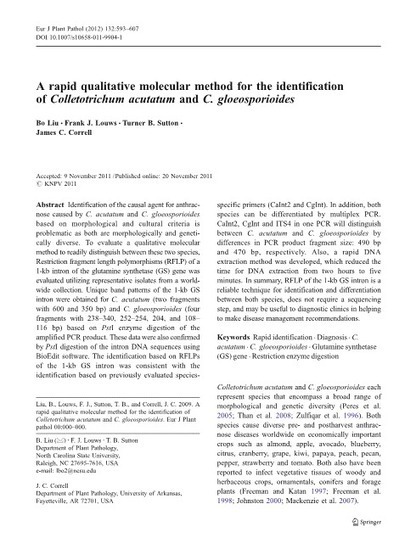Via Scoop.it – PCR PRIMERS FOR PHYTOPATHOGENIC FUNGI
Identification of the causal agent for anthracnose caused by C. acutatum and C. gloeosporioides based on morphological and cultural criteria is problematic as both are morphologically and genetically diverse. To evaluate a qualitative molecular method to readily distinguish between these two species, Restriction fragment length polymorphisms (RFLP) of a 1-kb intron of the glutamine synthetase (GS) gene was evaluated utilizing representative isolates from a world-wide collection. Unique band patterns of the 1-kb GS intron were obtained for C. acutatum (two fragments with 600 and 350 bp) and C. gloeosporioides (four fragments with 238–340, 252–254, 204, and 108–116 bp) based on PstI enzyme digestion of the amplified PCR product. These data were also confirmed by PstI digestion of the intron DNA sequences using BioEdit software. The identification based on RFLPs of the 1-kb GS intron was consistent with the identification based on previously evaluated species-specific primers (CaInt2 and CgInt). In addition, both species can be differentiated by multiplex PCR. CaInt2, CgInt and ITS4 in one PCR will distinguish between C. acutatum and C. gloeosporioides by differences in PCR product fragment size: 490 bp and 470 bp, respectively. Also, a rapid DNA extraction method was developed, which reduced the time for DNA extraction from two hours to five minutes. In summary, RFLP of the 1-kb GS intron is a reliable technique for identification and differentiation between both species, does not require a sequencing step, and may be useful to diagnostic clinics in helping to make disease management recommendations.
Liu, B., Louws, F. J., Sutton, T. B., and Correll, J. C.
EUROPEAN JOURNAL OF PLANT PATHOLOGY
Volume 132, Number 4, 593-607
DOI: 10.1007/s10658-011-9904-1
DATABASE RECORD: 530

